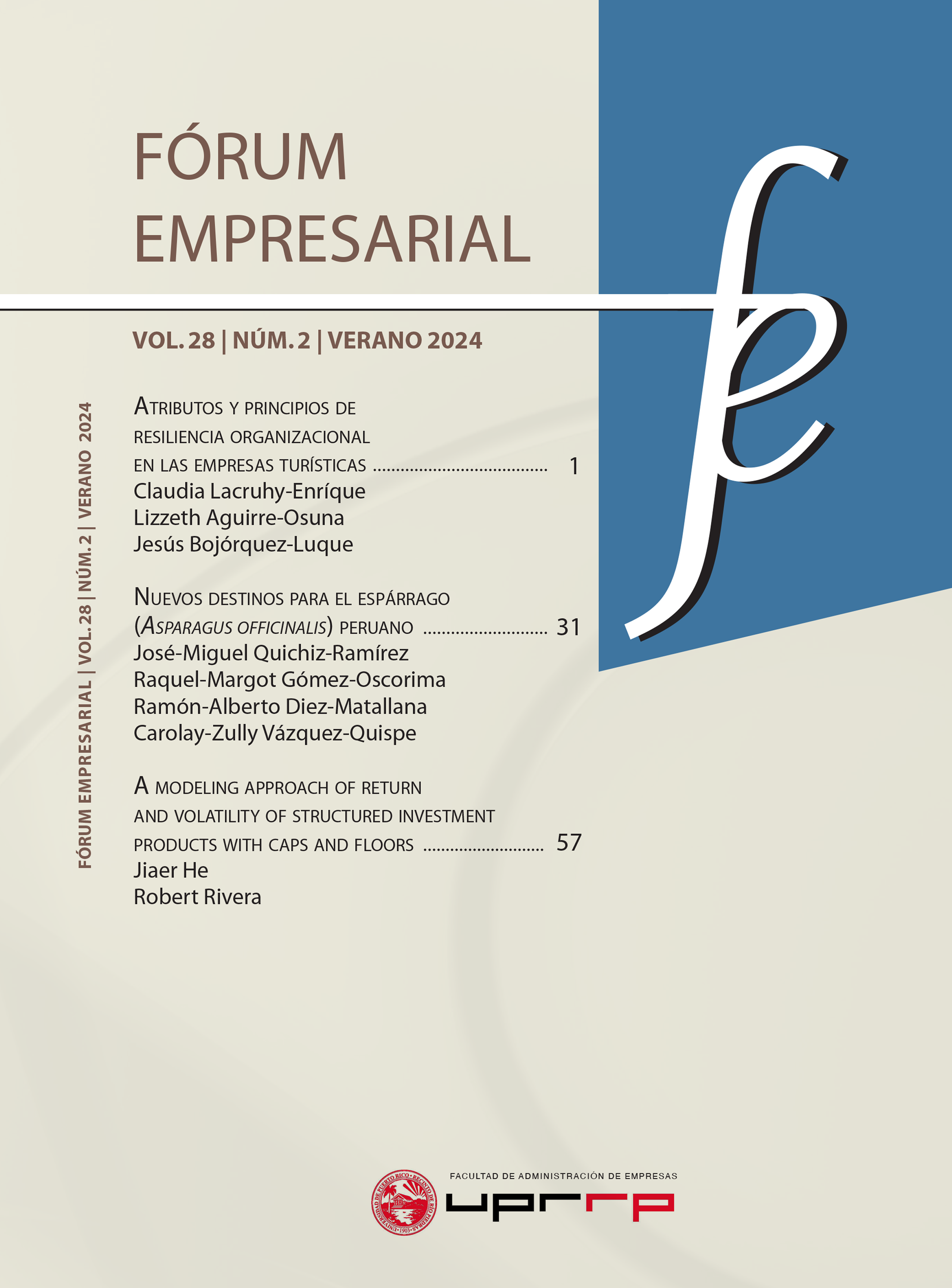Resumen
Un producto estructurado de inversión popular en Puerto Rico es la Cuenta de Retiro Individual (IRA) vinculada a la bolsa de valores. Estas ofrecen cierto crecimiento atado a la bolsa de valores mientras mientras protegen el capital. Este trabajo examina, por primera vez, el rendimiento esperado y el riesgo de las IRAs de la bolsa de valores de Puerto Rico (PRIRAs) y compara sus propiedades estadísticas con otros instrumentos de inversión después de impuestos. Proponemos un modelo paramétrico y lo aplicamos a PRIRA. Nuestros resultados indican que las PRIRAs tienen un rendimiento inferior al de invertir directamente en la bolsa de valores, aunque conllevan un riesgo relativamente alto dado su rendimiento. Las PRIRAs pueden ser razonables para algunos inversores reacios al riesgo debido a su protección del principal y aplazamiento de impuestos.
Citas
Afik, Z., Hadad, E., & Yosef, R. (2023). A guaranteed-return structured product as an investment risk-hedging instrument in pension savings plans. Risks, 11(6), 107. https://doi.org/10.3390/risks11060107
Austin, A. (2016). Puerto Rico’s current fiscal challenges. Congressional Research Service. https://digital.library.unt.edu/ark:/67531/metadc980459/
Blundell-Wignall, A. (2007). An overview of hedge funds and structured products: issues in leverage and risk. Financial Market Trends, 2007(1), 37–57. https://doi.org/10.1787/16096886
Bordalo, P., Gennaioli, N., & Shleifer, A. (2016). Competition for attention. Review of Economic Studies, 83(2), 481–513. https://doi.org/10.1093/restud/rdv048
Castro-González, K. C. (2014). Financial literacy and retirement planning: evidence from Puerto Rico. Global Journal of Business Research, 8(1), 87–98. https://ssrn.com/abstract=2323594
Célérier, C., & Vallée, B. (2017). Catering to investors through security design: headline rate and complexity. The Quarterly Journal of Economics, 132(3), 1469–1508. https://doi.org/10.1093/qje/qjx007
Damodaran, A. (2024). Annual Returns on Stock, T.Bonds and T.Bills: 1928 - Current. http://people.stern.nyu.edu/ adamodar /New_Home_Page/datafile/histretSPX.html
Deng, G., Dulaney, T., Husson, T., & McCann, C. J. (2013). Structured certificates of deposit: introduction and valuation. SSRN Electronic Journal, 23(3), 219–237. http://dx.doi.org/10.2139/ssrn.2303718
He, J., & Rivera, R. (2023). A modeling approach of return and volatility of structured investment products with caps and floors. arXiv. https://doi.org/10.48550/arXiv.2311.06282
Lugo, O., & Rivera, R. (2023). A closer look at indirect causes of death after Hurricane Maria using a semiparametric model. Disaster Medicine and Public Health Preparedness, 17, e528. https://doi.org/10.1017/dmp.2023.165
Malkiel, B. G. (2016). A random walk down Wall Street: the timetested strategy for successful investing. W.W. Norton & Company.
McCarthy, J. E., & Tower, E. (2021). Static Indexing Beats Tactical Asset Allocation. The Journal of Index Investing, 11-12 (4-1), 41–52. https://doi.org/10.3905.jii.2021.1.100
Rivera, R. (2016). A dynamic linear model to forecast hotel registrations in Puerto Rico using Google Trends data. Tourism Management, 57, 12–20. https://doi.org/10.1016/j. tourman.2016.04.008
Rivera, R., & Rolke, W. (2019). Modeling excess deaths after a natural disaster with application to Hurricane Maria. Statistics in Medicine, 38(23), 4545–4554. https://doi.org/10.1002/sim.8314
Rivera, R., & Rosenbaum, J. (2020). Racial disparities in police stops in U.S. cities. Significance, 17(4), 4–5. https://doi.org/10.1111/17409713.01412
Rivera, R., Rosenbaum, J. E., & Quispe, W. (2020). Excess mortality in the United States during the first three months of the covid-19 pandemic. Epidemiology & Infection, 148, e264. https://doi.org/10.1017/s0950268820002617
Rivera, R. (2020). Principles of managerial statistics and data science. John Wiley & Sons. https://doi.org/10.1002/ 9781119486473
Rivera, R., Marazzi, M., & Torres-Saavedra, P. A. (2019). Incorporating open data into introductory courses in statistics. Journal of Statistics Education, 27(3), 198–207. https://doi.org/10.1080/10691898.2019.1669506
Rosenbaum, J. E., Stillo, M., Graves, N., & Rivera, R. (2021). Timeliness of provisional United States mortality data releases during the covid-19 pandemic: delays associated with electronic death registration system and weekly mortality. Journal of Public Health Policy, 42, 536–549. https://doi.org/10.1057/s41271-021-00309-7
Sharpe, W. F. (1966). Mutual fund performance. The Journal of Business, 39(1), 119–138.
Sushko, V., & Turner, G. (2018). The implications of passive investing for securities markets. BIS Quarterly Review, 113– 131. https://ssrn.com/abstract=3139242

Esta obra está bajo una licencia internacional Creative Commons Atribución-NoComercial-CompartirIgual 4.0.
Derechos de autor 2024 Jiaer He, Roberto Rivera

